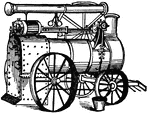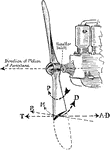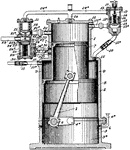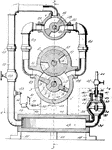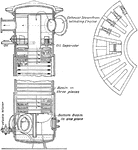
Interior View of Rateau Accumulator
"The accumulator may consist of a large tank in which are numerous plates over which water can flow,…
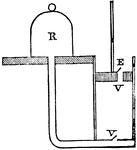
Air Pump
"The air pump is an engine by which the air can be pumped out of a vessel, or withdrawn from it. The…
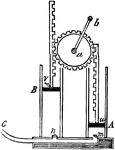
Air Pump
"The piston rods are furnished with racks, or teeth, and are worked by the toothed wheel a, which is…

Air-engine
"A motor employing the elastic force of air expanded by heat, or air compressed by means of another…
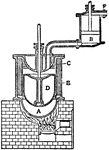
Stirling's Air Engine
"A form of air-engine which was invented in 1816 by the Rev. R. Stirling is of special interest as embodying…

Anzani Radial Motor, with Stationary Cylinders
This illustration shows an Anzani Radial Motor with stationary cylinders and its many parts: Exhaust…
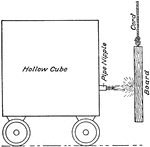
Apparatus for Measuring Jet Stream of Steam
"Suppose a hollow cube to be filled with some fluid (water or steam) at a given pressure, and to have…

Yorkshire Steam Wagon Transverse Boiler
A Yorkshire steam wagon transverse boiler. Water is continuously enters the large cylindrical container.…
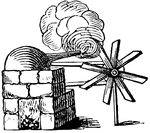
Brancas Engine
"In 1629 Giovanni Branca, an Italian, contrived a machine which was employed for the various purposes…

Building an Automobile, Step 01: Crankcase
"Crankcase showing bearings. The heart of the automobile is the engine. It is built around the crankcase,…

Building an Automobile, Step 02: Crank-Shaft and Fly-Wheel
"Crankcase with crank-shaft and fly-wheel added. The crankshaft serves the same purpose in an automobile…

Building an Automobile, Step 03: Cylinders Showing Piston and Crankshaft
"Cylinders showing piston in place and connected to crankshaft. Gasoline vapor is exploded in the cylinders.…

Building an Automobile, Step 04: Cogwheels
"The gears or 'cogwheels' are for running the fan, the pump and other parts." -Bodmer, 1917

Building an Automobile, Step 05: Cylinder Added to Crankcase
"Cylinder added to crankcase. The cylinders are next bolted down to the crankcase, the pistons and crankshaft…
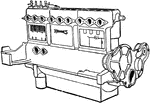
Building an Automobile, Step 06: Reservoir Added
"An oil pan or reservoir is attached to the bottom of the crankcase to hold oil for the engine." -Bodmer,…

Building an Automobile, Step 07: Carburetor
"The carburetor furnishes the gasoline vapor for the cylinders. It is connected to the engine by a crooked…
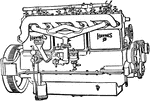
Building an Automobile, Step 08: Oil Pump and Filler
"Oil pump and filler added to motor. Oil is poured in the spout which is at the left of the carburetor.…
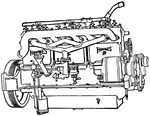
Building an Automobile, Step 09: Electric Generator
"The electric generator makes electricity to be used for starting the engine and lighting the car."…

Building an Automobile, Step 10: Magneto
"The magneto gives an electric spark, which explodes the gasoline in the cylinders. The water pump keeps…
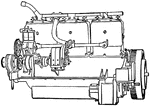
Building an Automobile, Step 11: Motor
"An electric motor starts the engine by turning the fly-wheel. This makes it unnecessary to get out…

Building an Automobile, Step 12: Transmission
"The transmission is added. The transmission makes it possible to reverse the car. It also enables the…
Building an Automobile, Step 13: Frame
"Double-drop pressed steel frame. The frame on which the car is built." -Bodmer, 1917
Building an Automobile, Step 14: Elliptic Springs
"Addition of semi-elliptic and three-fourths-elliptic springs to frame. Large springs are placed at…
Building an Automobile, Step 16: Rear Axle
"Showing addition of full-floating rear axle." -Bodmer, 1917

Building an Automobile, Step 17: Engine and Transmission Attached to the Frame
"Completed engine and transmission is next fastened to the frame and connected to the rear axle by the…
Building an Automobile, Step 18: Gasoline Tank
"Showing addition of gasoline tank and gas lead to carburetor." -Bodmer, 1917

Building an Automobile, Step 19: Steering Gear
"Showing how steering gear is connected." -Bodmer, 1917

Building an Automobile, Step 21: Radiator
"Completed chassis with radiator added. The water which keeps the engine from getting too hot is pumped…

Steam Engine Valve Centered with Piston
"It is usual to put the engine on center before setting the valve. First put the engine in a position…

Top View of Six Cylinder 1910 Rolls Royce Chassis with Engine and Axle
An illustration of the Rolls Royce chassis with engine and axle viewed form the top. A chassis is the…

Chica Ballapure Engine
"The Chica Ballapura engine consists of two upright rollers, A, the heads of which are formed into double…

Colonel Crompton's Superheated Steam Tractor
A superheated steam tractor built by Colonel Crompton. The boiler, located in the front, heats the water,…
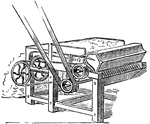
Cotton Gin
A Cotton Gin (short for cotton engine) is a machine that quickly and easily separates the cotton fibers…

Crank
"The simplest idea of a crank is that of a handle to a wheel; its action is familiarly illustrated in…

Eccentric Motion of the Steam Engine Crank in Full Gear
"When set full gear forward, the valve admits steam to the crank end of the cylinder, and the crank…
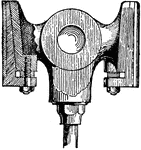
Crosshead
A beam or rod stretching across the top of something; specifically, the bar at the end of a piston rod…
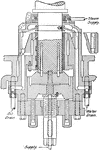
Cross Sectional View of Curtis Turbine Step Bearing
"The upper bearing with dowel—pins and key fit into corresponding dowel holes and key—way…
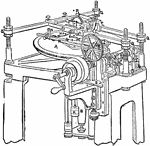
Dividing Engine
"The plate A is 46 inches in diameter, and is composed of gun metal. These were put on by original graduation,…

Dixie 4-Cylinder Magneto
End elevation and section of Dixie 4-Cylinder Magneto showing construction and connections.

Double-acting Cylinder
"The first alteration to be noticed in the double-acting engine is that of the cylinder. To insure its…

Double-acting Cylinder
"The first alteration to be noticed in the double-acting engine is that of the cylinder. To insure its…
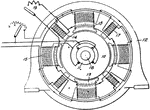
Electric Machine for Dynamo
A generator consisting of a coil which rotates between the poles of an electromagnet causing a current…
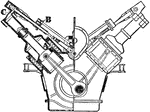
Bentley Eight Cylinder Diagonal Tandem Compound Superheated Steam Engine for Tractor
A eight cylinder Bentley superheated steam engine fitted to a tractor. The steam is used to move the…
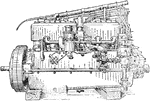
Carburetor Side View of Six Cylinder Rolls Royce Engine
A six cylinder Rolls Royce engine viewed from the carburetor side. The carburetor is used to mix air…
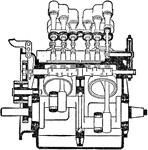
Sheppee Motor Company Compact Double Acting SUperheated Engine
"In this engine the cam—shaft by which the steam and exhaust valves are operated is situated midway…

Internal Combustion Engine
This internal combustion engine comprises of fuel combustion which occurs with an oxidizer in a combustion…






